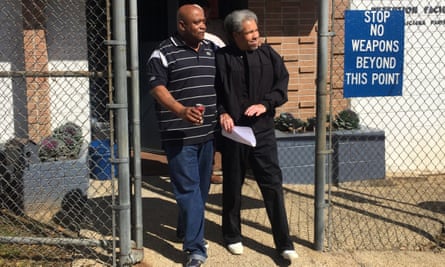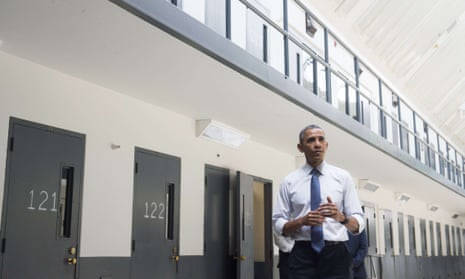The Obama administration is pressing individual states to join its mission to cut back on the use of solitary confinement in US prisons, in the hope of reining in a practice that is still widespread despite having been denounced as potentially amounting to torture.
The drive from the White House and Department of Justice is tacit recognition that without the cooperation of state corrections departments and legislatures – many of them Republican-controlled – the goal of reducing solitary confinement will remain a pipe dream.
There are as many as 100,000 people in segregated cells in the US, a number that sets the country apart from most of the rest of the world and exceeds the entire prison populations of countries such as the UK, France and Germany.
This year Barack Obama announced far-reaching reforms that would dramatically reduce the use of solitary, or “restrictive housing”, within the federal prison system. He said the practice of placing inmates in tiny cells with virtually no human contact was overused and an “affront to our common humanity”.
Without support at state level, however, he is stymied in his wider ambitions. The figure of 10,000 prisoners held in isolation by the federal Bureau of Prisons (BOP) is dwarfed by that of as many as 90,000 inmates kept in similarly harsh conditions in state-run prisons.
They include as many as 25,000 people held in total isolation in “super-max” prisons, which have proliferated over the past 20 years across at least 40 states. Super-max prisoners are kept in 6ft by 9ft cells, typically for up to 23 hours a day with minimal or no human interaction.
Roy Austin, the president’s deputy assistant for urban affairs, justice and opportunity, and a leading architect of the administration’s drive to reduce the use of solitary confinement, said the federal government was well aware of the need for state backing.
“We know a lot of change is local,” he said. “In the criminal justice space we represent a small percentage of the number of people arrested and incarcerated, so we are here to provide technical assistance, to learn from states that are getting it right and to serve as a shining example of what can be done.”
Many have condemned solitary confinement as a practice that could amount to torture, including the UN special rapporteur on torture, Juan Méndez, who has called for a global ban in all but exceptional cases. Scientific research has revealed the adverse psychological effects of locking away prisoners in segregated cells, with some individuals suffering serious depression, suicidal thoughts and behaviour, hallucinations and paranoia within a matter of days.
The federal effort to sew the seeds of change at state level began almost immediately after Obama announced his reforms in January. Two weeks later, the White House and the Department of Justice hosted a discussion for state leaders on the impact of solitary confinement on budgets, prison officer morale and safety. Some 116 officials and politicians from 37 states as well as Washington DC and Guam joined the conference call. A similar exercise was staged last month for non-governmental advocacy groups.
The administration is also working to spread the message by incorporating its 50 new “guiding principles” on the use of solitary into the training programme for corrections officers offered by the National Institute of Corrections, and it has worked with the New York-based Vera Institute of Justice, which is pioneering a new approach to incarceration under the rubric “safe alternatives to segregation”.
A further tactic is to encourage professional bodies such as the American Correctional Association and the Association of State Correctional Administrators to wield their influence at the local level.
Leading advocacy groups such as the American Civil Liberties Union have lauded the drive to bring states on board. “Most of the battle is at the state level,” said Amy Fettig, senior staff counsel for the ACLU’s national prison project.
“Having President Obama speak out on this issue is huge, and having the largest prison system in the country, the federal one, move to reduce solitary confinement is very meaningful,” she said. “But that still leaves us having to go state by state, calling on individual jurisdictions to change.”
The White House has given federal agencies including BOP and the justice department 180 days to implement the main reforms that Obama outlined in January. That involves taking mentally ill prisoners out of solitary and into special care, ending the subjection to segregation of LGBT and other vulnerable prisoners, restricting the use of isolation as a punishment for routine misbehaviour and banning all segregation of inmates under the age of 18.
Between 20 and 30 states regularly participate in training events on reducing disciplinary segregation, and the Obama administration hopes to build on that number. Some, such as Colorado and Washington, have been national leaders in developing new procedures that reduce the practice, and the administration has borrowed from their example in putting together the president’s reforms.
Colorado has slashed the number of inmates it holds in isolation over the past five years by giving prisoners in segregation cells the chance to claw their way back to the general prison population, including via activities outside their cell, education classes and counselling. “The new system is structured to create pathways out of solitary confinement for most of the segregated population,” said Steve Martin, a long-time corrections consultant.
At least 13 other states have already rewritten their rules or are in the process of pushing bills through their legislatures to cut down on the practice.
The wind of change is also blowing through cities such as New York, whose corrections board has banned isolation cells on Rikers Island for inmates aged 21 or younger. Segregation will be phased out from all New York city jails for inmates aged 18 and under from the end of June.
As improvements spread through the country, the spotlight falls increasingly on a rump of states who remain resistant to change - states such as Louisiana , which notoriously held Herman Wallace and Albert Woodfox of the so-called Angola Three in total isolation for more than 40 years.

Another is Texas, where the ACLU has calculated there are 6,564 prisoners in bare concrete cells with solid steel doors. And then there is Florida, which holds more than 12,000 prisoners in segregation – more than the whole federal prison system.
Florida underlines the dilemma Obama faces as he seeks to make a real impact on the prevalence of solitary confinement before he leaves the White House in January next year. The state has almost 50 inmates under the age of 18 held in isolation in adult prisons.
One of the biggest reforms the president announced was a ban on the segregation of prisoners under the age of 18, but the federal injunction is of only limited value unless states such as Florida follow suit.
Last month a group of civil rights and religious groups in Florida wrote to the justice department calling for a federal investigation into the state’s use of solitary. The move points to the stick that the Obama administration can use should the carrot of its own example fail to sway wayward states.
A senior justice department official who was part of the central team that drew up the president’s reforms and who is now involved with discussions with state officials, declined to comment on pending investigations. He said, however, that the department’s civil rights division had been closely involved in framing the reforms.
“The civil rights division has been very active and is committed to this, and when they receive referrals they will take appropriate steps to ensure that every state as a minimum does what they are required to do under the US constitution,” he said.
The Obama administration believes it has a number of winning arguments to bring around hesitant corrections departments. Foremost is cost. A 2007 study estimated the cost of a single super-max cell at $75,000 (£52,000) a year, roughly three times as much as holding a state prisoner in ordinary secure accommodation. “It costs an enormous amount of money to continue with solitary, and it is not making us safer as a country,” Austin said.
A more sensitive argument is that reducing solitary improves security inside prisons. For many years the assumption has been the opposite, that putting unruly prisoners into segregation increases safety for staff and other inmates. But there is evidence that prolonged isolation can cause violent behaviour in prisoners.Part of the new push at state level is to show state correctional officers that a more humane approach to housing and ensuring staff safety are not mutually exclusive.
“It’s one thing to have the head of a state correctional department say this is worth doing, it’s another thing to have a prison officer who actually walks up and down the cells embrace this as a good idea,” the senior justice department official said. “Some folk are worried that if you take people out of solitary it will make the facility more dangerous, and we are trying to show that is not necessarily the case.”







